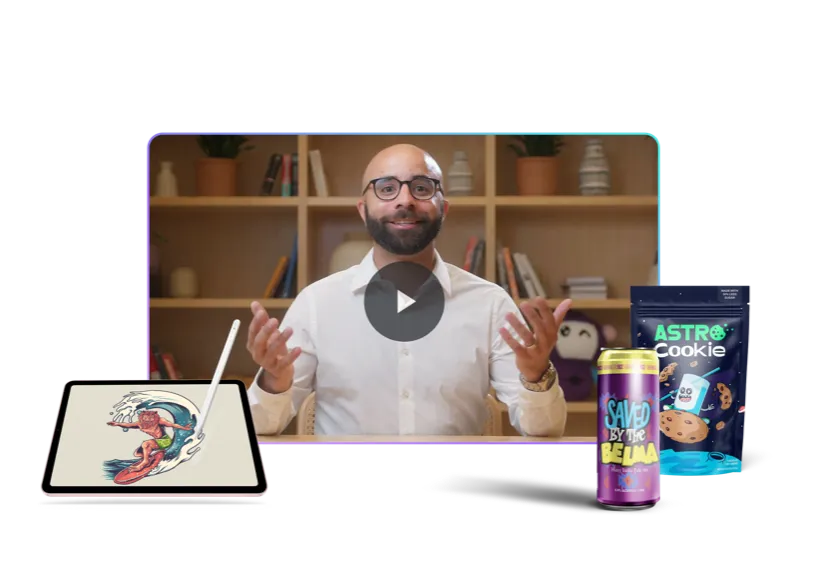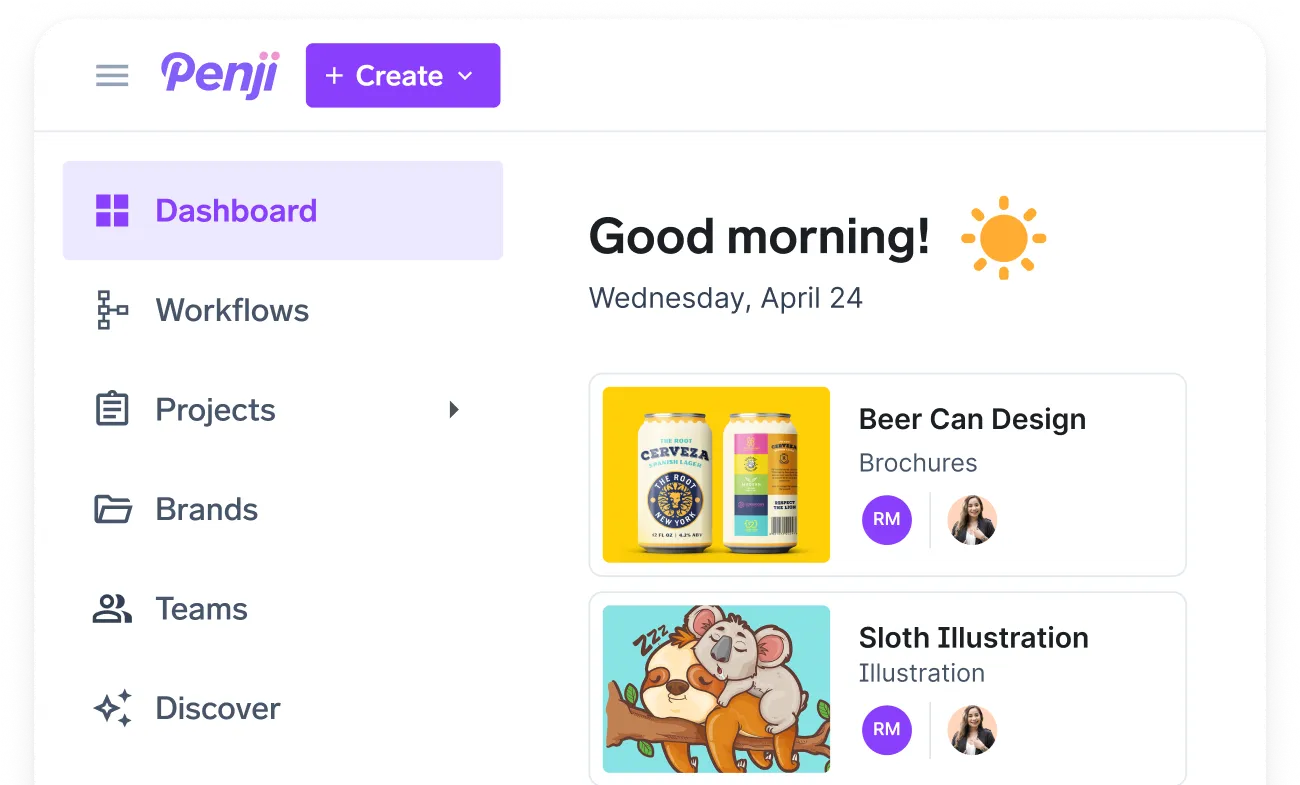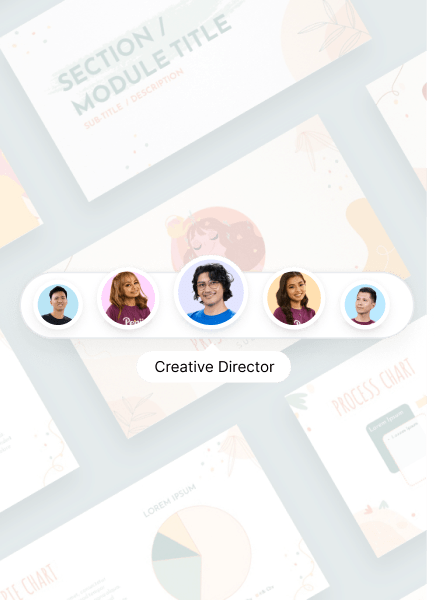![[Fully Managed] Connor DeLaney from IMPACT Plus Ep. 153](https://penji.co/wp-content/uploads/2025/07/BLOG-IMAGE-Connor-DeLaney.jpg)
Shannon (Host): Hello everyone, and welcome to the Fully Managed Podcast. The podcast where we discuss marketing and business tips to help assist you on your business journey. I’m your host, Shannon, Penji’s partnership coordinator. I’m joined here today with a very special guest, Connor Delaney from Impact Plus. Thank you so much for joining me today.
Connor: Excited to be here, Shannon. It’s going to be a fun conversation for sure.
Guest Introduction and Background
Shannon: I appreciate that. So could you just start by introducing yourself, telling us maybe a fun fact or two and then talking a little bit about how you got to this point, your professional career?
Connor: Yeah, so I am Connor. I am the lead sales consultant at Impact, but that has only been my role for about the last year or so. Before that, I did what I like to call the Endless Rotation program, where you work in the agency world or in the marketing world, and you find a way to have new titles every once in a while.
But I started out, as, you know, a content trainer. I helped teach people how to write great content. And we focus in inbound marketing world. You know, if you think of HubSpot, that kind of world, that’s where our bread and butter is. But I taught people how to write great content to get people to convert on their website.
And then I moved into an events and community management role for a couple of years where I ran a community called Impact Plus, where we had a couple thousand members who would engage in mastermind groups and other learning courses and other content. And I ran that community for about two years before I jumped into a sales role, helping businesses to get on the journey of working with Impact.
And so that’s my super quick spiel. I’m sure we can dive into some of the details, Shannon, But that’s, that’s what’s gotten me here. And I guess a fun fact, I could come up with different ones. I would say I’ll go with a personal one. I played in the Babe Ruth World Series when I was 14 and represented New England four for our baseball team, which was really cool.
Otherwise, I also have a dog named Mabel, who is a four and a half year old Aussie shepherd, Aussie cattle dog mix. And funny enough, yesterday was our two year gotcha day.
Shannon: Oh, congratulations.
Connor: Yeah, she’s. She’s our little angel. She’s a little gremlin, too. But she’s a lot of personality with those kinds of parts.
Shannon: I love dogs that are little gremlins.
Connor: And these she lives it up, but she also is spoiled. And we her.
Shannon: That’s the best kind of dog. I love dogs that get into mischief. I think those are.
Connor: And she is she’s smart enough to know what she’s doing, too. She doesn’t stumble in. This is a calculated attack.
Shannon: Oh, yeah, of course. Yeah. I love dogs that are stubborn in their own right. Like they don’t. They know when they’re not listening, like they know how to listen.
Connor: Selective hearing is pretty common at times. Yeah. Shaggy for that’s me in a nutshell. And that’s, that’s how we ended up here today.
Career Reflections and Lessons Learned
Shannon: Well, thank you for introducing yourself so effectively. That was actually a really good a lot of people do it in a really long time. No shade to them. I think they’re doing a great job.
Connor: It’s easy to fall into that trap. I find, you know, I’m sure there’s questions and ideas and things maybe your audience wants to know, but I try to give the 20 seconds synopsis and then if you’re interested, we dive deeper as well.
Shannon: I actually didn’t have a question about that. So since you’ve been in so many different roles, do you have a favorite that you.
Connor: Like picking kids?
Shannon: I’m sure you might be biased that you have to say the one now because you’re doing it currently. But yeah, something that you really enjoyed, or maybe rather this might be an easier one, something that you think taught you the most along the way.
Connor: Well, yeah. Okay. So, so here’s what I’ll say as we did a little bit is I would say the role that I learned the most from was building and growing the impact plus community, because we the way that we did it was we built our own platform. So we had we built a platform from scratch. It took a lot of work and within that I was learning how to run events online because that so that was happening 20, 20, 2021.
So everyone’s going online and figuring that out, but also like growing a community from pretty much zero into a thriving community with paying memberships with active members, but also from the product side, building a product that our members want to use. So I would say for me it became a product or a commute. Call me a community manager, a manager or a membership manager, whatever the title might be.
My job was to build the community, grow the community, retain the community. So what I was learning was pretty much how to run this as its own little micro-business of I had revenue targets I had to hit, I had retention metrics, I had to learn how to manage a budget when it comes to building a product and products are not cheap and you learn all these different aspects.
There’s always going to be things, you know, for sales, the biggest learning I’ve had is communication. How do I become a more effective and efficient communicator? There’s different lessons you learn in every role, but the one that taught me the most and was most well-rounded was me in that we’ll call it Director of Membership, I think was the official title.
But you can kind of you can make titles at that point that they’re all doing the same thing as grow, build, maintain the the community that we have.
Shannon: No, I think that’s a really nice role to have in the marketing field or at some point in the marketing field, because if it is adjacent to kind of running your own like little business, it almost helps you work with businesses in the future because you kind of have been in that position in that role to be able to think about all of these different aspects that that person is thinking about and be in their shoes.
Connor: I do think you learn how to communicate value, and I think that was if I was going to captured. In one sense it was like, how do I communicate and continue to communicate value to our members? Because there is a million memberships or subscriptions that you can have. How do you continue to showcase that yours is worth keeping on that credit card or on, you know, on the bill or the invoice every single month?
How do you provide enough value? But also how do you communicate that to folks for new members to sign up and for existing members to say, I’m so glad I’m a part of it too? So yeah, from the marketing side, you’re learning all these different things. And the difference I’ll say this to the difference between marketing to members and marketing your product to people.
Product marketing is so different than just, you know, marketing out to customers to buy. You have to learn how to communicate updates, how to communicate new features. That was its own challenge, but also an exciting thing to take on as we were building it.
Evolution of Marketing Careers
Shannon: Yeah, no, I really like the evolution of the people’s experiences in the marketing field because I think it’s very I actually say this a lot, so I feel like I might be repeating myself, but I’m like a very non-linear experience for marketing. Like I feel like no one’s just marketing coordinator their whole life, you know? And I and I like that a lot because I think that everyone does things very differently and there’s so many different approaches to doing something quote unquote, correctly or successfully initially today.
Connor: Then I don’t mean to cut you off the line. Even when I graduated from college, what, six, five, six years ago now, like the world of marketing is drastically different than it was back then. And so you can’t just graduate and do the same thing you’ve always done because you have to learn how to evolve and how to be successful.
And I think for marketers, that’s like the biggest skill they can have is how to adapt and evolve and change your strategies as you go. Because if you get too comfortable, you’re probably falling.
Brand Evolution and Innovation
Shannon: Oh yeah, no, for sure. I actually just had a conversation the other day about the larger corporations and how they kind of fall into the trap of what is what is the word I was looking for. Like, like loyalty in brand loyalty. And the idea that they stop coming up with new creative ways of marketing their business because they’re just kind of like we’ve been around long enough that people trust that we have it.
But there’s so many cases in which big corporations just lose so much of their customer base because, you know, they’re not doing anything new or innovative or exciting. And I think falling into that hole is something that’s kind of detrimental. And you constantly have to be evolving in the marketing world because the marketing world is something that changes so quickly.
Connor: Yeah, yeah. And it’s now more than ever. It’s and this is where a lot of businesses who work with us are leaning into is it’s easier now than ever to be an industry disruptor. So to your point, the big players get comfortable. The young, you know, the the startups, the newer companies are the ones that are trying to shake the tree.
And if you can’t evolve and lead the charge, someone else is going to show up and do it. And now more than ever, you have the tools and the capabilities to be a player in a market that was probably looked at two or three years ago that was impossible to make even a dent into.
Shannon: Exactly. And I think that’s one of the biggest accomplishments that someone can make. As you know, a smaller business or a startup is doing that. Exactly. And I think it’s it’s not not to take away from how hard marketers work in these positions, but sometimes I think that one good idea can go so far because it’s just it like I think it just comes down to being attention grabbing and also being unique, like not willing.
Connor: To do things differently. Yeah, that’s a huge component. And so many people, to your point earlier, like fall into, you know, we call it the pride cycle with new idea, really exciting. We’re doing things, we get comfortable and we stop doing the things, we stop seeing the results. And it’s this endless cycle. But a lot of the bigger companies make it really difficult to do new things because they’re so established.
Your point, Everyone knows us. They’re going to come by from us. It’s not always the case anymore, and it probably won’t be if you unless you do something differently.
Shannon: Yeah, I really do. I love to see the way that people kind of get to this popularity from something that I’ve never heard of. Like I keep looking into stories like that of a brand that or even of big brands that kind of I haven’t heard about in a long time. And then they’re on, you know, my my Instagram feed or something like that.
And I just like the gap. I keep thinking about Gap. I have not heard about Gap. I like Gap sold the same clothes for 25 plus years and then recently they’re on my feed and they’re making something completely new. And I’m like, Oh, that’s really good for them here. They’ve definitely been, you know, they probably just weren’t doing well for maybe a while, but they were still here.
But it’s nice that I love when I see bigger businesses changing things up, but I also love seeing a new business on the horizon kind of combat these businesses. And I think that’s just they’re doing something new and innovative.
Connor: Definitely. Definitely.
Future Predictions for Marketing and Sales
Shannon: Oh, so okay. Question about that then what do you think? And I know this is very hard to predict because marketing is very different every day.
Connor: Yeah.
Shannon: What are you thinking? Maybe five years? What kind of just do you think you might see in marketing or even sales that will be different from now?
Connor: Oh, okay. I’ll give you the layup answer and then maybe one that’s more fun. In the next five years, one guy is going to be everywhere. And when I say I, it’s not just like search results, but I think we’re going to see things like avatars on websites. I think we’re going to have libraries of content that you no longer need to read, but you can just ask a bot, What’s the answer to this?
And they’ll pull it for you. And it’s educated because of your business, gave it resources. I think that’s the easier. One of AI is going to be everywhere and it’s going to change the way that, that customers buy. And it’s already shifting, right? Like Google, Search results are changing a lot. SEO is becoming less and less of a not say less of a thing, but it’s harder to do and it’s different than it’s ever been before.
The one that I think is a little more interesting and unique and it comes to marketing and sales is, I believe, every business in the world in the next. I would even say like next 2 to 3 years will have some form of a pricing calculator or self-service experience on their website because of the way air shifting, how marketing is done and how you get in front of customers.
The customers that land on your website are going to be probably further down the funnel unless you’re those national known players. So when they’re further down the funnel, they need different information than they used to. You know, writing an article about, I don’t know, some high level like what is a let’s just find an easy example. What what kind of materials can I use to fix my roof is way different than how much does it cost to fix a roof?
When you’re talking materials, it’s kind of like earlier ish. You know, you’re trying to educate yourself when you talk pricing, you’re showing intent to buy. So I think websites are going to shift a bit from the draws many people in as possible to educate and convert at the highest level. And we’re going to see I kind of replace that earlier stage because it’s going to give them the answers to those easy questions.
And the pricing ones are going to be where you not only differentiate and I don’t mean differentiate in the way of cost less, but explain how pricing works. That would be my prediction is in the next five years, every company will have to have one of those for them to survive.
Educational Marketing and Trust Building
Shannon: I really like the idea of that because I do think that’s something new that I’m seeing now in marketing is the educational aspect of things, because I think like once you teach something, something to someone that they didn’t know that idea or fact prior, now they’re suddenly concerned about it. You know.
Connor: You never.
Shannon: Know. And I really hope.
Connor: You know what that does for your brand. Shannon, as you become more trusted because you educated on something that they probably weren’t thinking of before to.
Shannon: Know, I think and it works. I it it does work and it and it can be something that I didn’t know or care about before I ran up on it. And now I suddenly care about it and want to buy the product. It does work because it’s kind of the idea of, you know, doctor Googling something like, I have the symptom, I need to figure out what’s wrong.
But it’s the opposite way of like new. You’re finding out that something’s wrong, right? Little marketing.
Connor: Yeah. Yeah. And that’s that the role. But that’s also where, like, sales and marketing are going to be closer than ever because it’s marketing’s job to educate them. It’s sales job is when I’m educated enough to want to talk to you, can you close the door and close the deal and win the business? But if marketing gets them 80% of the way, they’re 90% of the way, their sales should be easier.
But it requires a lot of coordination with the marketing team. And that’s probably a broader trend that’s happening now, but will be even more prevalent is those teams are going to have to be closer than ever for them to be successful.
Sales and Marketing Alignment
Shannon: Oh, so actually, that brings up a really great question. So you have worked in both sales and marketing and currently work in both. How do you kind of coordinate those two together? Because I know that’s kind of like a thing that butts heads very often two departments kind of coordinating with each other.
Connor: Yeah. So a lot of the work that we do as well, and I guess I didn’t cover this as much in who we are, what we do, but impact as a company, focus on training sales and marketing teams to be more effective and more aligned than they are right now. And so for Impact, we work to set the example and we’ve created what we call a revenue team, which is members of the sales team and members of the marketing team meet every two weeks to plan out content strategy to talk about experiences that I might be having in the sales process and how marketing can help.
And that’s been a game changer because not only is marketing creating content that’s valuable for me to use, it also means that it’s valuable because it helps the buyers to have the resources that they need or the customers or prospects. But the other piece that it does is it requires us to communicate with each other on areas that we might be missing.
Things like, Hey, the website was missing something about this. Can we create like identifies gaps and in that sense gives marketing one job security because they have new things to go work on and create, which I always think is just a funny way of putting it. But it is true like it keeps them busy in a sense, but it also ensures that while we’re not going to always be like right, but we can bring back experiences from the front lines and say, Here’s what I’m seeing and hearing.
How do we solve this problem together? And sometimes I’m going to have ideas. Sometimes I’m going to throw my hands up and say, I have no clue, but I bet you guys do. So it’s giving them real life data and insights into what we’re experiencing when we’re trying to sell or we’re trying to educate and nurture an opportunity.
That’s how that’s how we’re doing it and that’s how we help companies that we work with do it too.
Shannon: Oh, I really like that. I think communication is something that’s so vital to the success of a business.
Connor: And having a role in it, like a game changer from that.
Shannon: Especially, I think you’re always, especially when you’re just working within a department and you’re not really getting communication elsewhere. You’re kind of working in like this feedback loop, right, of information where even if something’s working, quote unquote, you don’t actually see that it can be better than what’s working at that point. And I think that outside perspectives are really important, even for something as simple as, you know, the website, like looking at it over and over again, it becomes your baby.
And it’s something that’s so hard to get new ideas for because you’re kind of this like, Oh, this. You’ve worked so hard on getting it to this point.
Connor: And you’re at it every day. It starts to look like everything else and all you see is the color of your site kind of thing. Yeah.
Shannon: Exactly. And I really like the I think communication from different positions is something that is really important and not something that is really implemented. I think startups are really good at it because they’re a smaller.
Connor: All altogether usually. Yeah. Or you learn local ads. Yeah. As you get bigger, it gets tougher. But also that’s where, you know, when we say bigger, there’s like there’s startups where you’re three guys in a garage or there’s the companies that are 30, 40 employees, maybe they’re $10 million and they’re they’re big enough where they have to have structure because it’d be easy for them to separate.
But the more that they stay together and they stay aligned on where they’re trying to go, the more effective we find they are. And the same thing for our team. We’re more effective when we’re all aligned and rowing the boat in the same direction.
Shannon: Well, yeah, I think that well, one, I think that education is really important. Like it’s really interesting and cool that you guys do that specific leave because I think that that’s just not something that even bigger companies have an issue with because it’s just like they’re unaligned in the way that they’re thinking about things. And I think that’s where like the butting heads comes.
Connor: Yeah, it eliminates pointing fingers and butting heads. That’s right. Yeah. That’s that’s always where I say always. That’s most of the time where teams start is they’re pointing fingers at each other saying marketing’s not making or like sales is in closing the deals we’re creating. And then sales are saying marketing is not getting us enough leads and everyone’s not working in the same way.
They’re all just saying, You’re not doing enough to make me successful. What the heck.
Common Marketing and Sales Mistakes
Shannon: Yeah, No, I think. Wait, so with that, I think that definitely is a big issue that we both agree on for sales and marketing. What do you think is another kind of common mistake that sales and marketing teams are making in their strategies towards being successful in their campaigns?
Connor: Oh, okay. One that comes to mind right away is we talk too much about ourselves, and that’s probably an easy one. And I saw you giggled as I said it. So maybe that’s one you’ve heard before asking why, but it’s one of those things of like, whether it’s in our copy, it’s in the content we create, it’s in the sales conversations we have.
We tend to really focus on us and not on the customer. And that can look different in different ways. So for the marketing team, if we think about our home page or our services pages, we talk about how great we are. If you, you know, a simple search I do is you do command F and you just see how many times do we say we ice our versus you, yours they kind of thing.
How much are you talking about yourself versus other people in your copy itself? When you think about your content, your writing, how much of it is really biased and not helpful, but just kind of like we did a great thing and you should work with us because of that. And then in the sales process, it’s going into what I call the pitch slap, which is you come in, this customer says, I’ve got a problem, and I come to the rescue and I say, I’ve got a solution for you.
And it’s kind of like the used car salesman of I come in and I just want you to buy. And it’s not actually learning what their problems are. It’s not communicating that to them and getting them saying, I want help to solve this problem. Instead, you’re saying, here’s what we do. Does that work for you? I would say that’s that’s another big problem.
That’s probably a more obvious one. But I would say there’s still way too many companies that do it too.
Shannon: Yeah, no, I can definitely understand that. Me personally, I’m so far from sales. Like, I just it, it is something that universally.
Connor: And I said the same thing three or four years ago and look where I am now, depending on what happens. It’s funny how it happens.
Shannon: It’s so daunting. I really pat them on the back for.
Connor: Bringing up.
Shannon: The coordination is great. I really appreciate our sales team because I think they do an amazing job, but it’s something that’s so terrifying to me as a concept and I really I just respect the ability to be able to be in that position so much because I you, you know, marketing is one thing, but sales is another. And it’s kind of like, you know, if one or the other is not doing its their job, well, then we, you know, every both are at a detriment, right.
Connor: Yeah. They’re so dependent on each other and yet it’s so often they don’t work together.
Shannon: Yes. And I think that’s really vital.
Really. So yeah, it’s really it’s really nice to hear that perspective of one that you work in both positions, but also that, you know, impact. Plus does this specific arrangement where I don’t hear about that very often, I’m sure there are many agencies I talk to agencies that probably the most I think that there are there is that structure in agencies probably often, but it’s not talked about enough in like its importance for it.
Connor: Yeah, it’s, it’s a cool thing but it’s also imperfect. And I say that in the sense of, you know, as much as we try to also train teams how to do it, we’re trying to set the best example, but we’re also kind of the guinea pigs of it, of what can go wrong or how can. And now I’m on the other side.
I used to live on the marketing side, Now I’m in the sales side. It is tricky because I want to be on calls doing my job and I’ve got to make time to work with the marketing team. And it’s a discipline thing, I think more than that.
Shannon: Yeah, of course. I think that it is it it also is somewhat disappointing when you don’t have as many calls, but I think also it’s nice that you had the perspective of a marketing position though, because I think that, you know, everyone says marketing is a gamble. Like you can do somewhat everything right statistically like with evidence, but it might just not work.
And I think that it’s nice to have that perspective as you know, as someone who is in sales, because I think that’s something that, you know, when you when you aren’t given enough or you’re not on enough conversations, kind of feel like inadequate.
Connor: Yeah, yeah.
Shannon: But it’s good to understand that sometimes there’s highs and lows and it’s just something that comes with the job.
Privacy vs. Personalization in Customer Data
Shannon: So moving topics just a little bit. Okay, So there’s this growing demand, I think, and I think in some times it has to do with AI because I think a lot of times when things are automated, so to speak, I think a lot of people kind of lean more towards wanting personal experiences because it’s kind of a what’s the word I’m looking for, like a consequence of it because people are looking for, you know, they want to feel like they’re individual and they’re not just talking to a robot all the time.
How do you think that companies are able to balance the need for this customer data to personalize experiences while also respecting privacy?
Connor: Okay. The yeah, the privacy versus we want to know everything about you kind of. Yeah, well, I think the threshold for customers is going up in the sense of I’m going to give my information when I absolutely have to. And so brands have to adopt ways to gather that information and also to give as much as they can in a way that’s not going to be detrimental.
So for me, what I think about is I want the information of people that I should be spending my time, money, energy talking to or and that’s that’s from the sales side, but also from the marketing side. I think we tend to spend too much time trying to get information from people we actually can’t do business with or we can’t work with.
And so what that leads to is we’re trying to be the net that catches everything versus the fishing line that catches the fish we want. Now, I just made up that analogy, so hopefully it fish.
Shannon: That’s great.
Connor: But I’m operating in an idea for me. I would rather us focus on when we get more, we’re going to get information from the people who are actually ready to give it. There are some businesses that you know you’re going to go download an e-book. We need your name, email your street, address your Social Security number every little bit and nook and cranny about you, when really we should be giving that to them in a format that makes it easy when they want to buy from us or they want to have a conversation with the sales team, ask for the information we need, I think that’s totally fine.
But when we think about things like A.I., what I think it’s going to unlock is how do we help people get to the information they need faster and more efficiently so that they make that next decision faster and more easily. So to that point, how can we utilize AI to eliminate the fluffy tire kickers that are, you know, if we think of the funnel that top of the funnel, how do we get rid of the people who really are not a good fit for us that aren’t going to like we don’t need their information because we’re probably going to spend too much energy trying to make them something they’re not.
And instead I can get them where they need to be or disqualify them faster as long as it knows what needs to be true. And then you’re that way. You’re optimizing your people to interact with the people who are going to buy from you. So I can make you more efficient in that sense without you needing to invest a ton of, you know, for example, channeling, you shouldn’t be investing a ton of your time trying to find people that aren’t a good fit for Benji and Fred.
You should be focusing on getting more people that can buy from you, want to buy from you, and that you can help succeed to get the outcomes they want. You want to work with more of those people because they’re going to want to pay for you, they’re going to want to use your services and they’re going to want to make money off of those services, I imagine, too.
So that’s how I look at it with AI is it’s going to it should scare teams that are used to working at low volume versus the ones that are focused a little bit more on quality. Yes, there’s people you’ll nurture. That’s part of this is like get them in the door and get them working. Make it easy to get into that flow and utilize AI and other tools to build that journey for them.
And that way it’s making them more efficient. Yes, you’re going to need some day to do it, but over time they should be giving it to you as you build the case with them. I should make that easier, in my opinion.
AI-Powered Customer Interactions
Shannon: Yeah, of course. I think that’s almost something that I really love about marketing and like catering this in experiences surveys like Tiny Survey and I think that AI is kind of like when, when we do implement that more in that way to individualize services. I think that surveys it’s kind of it kind of will be a survey in a way because there will be like a questioning that kind of puts people in different boxes of whether they need the service now or they might need it in the future or whatever may be.
And I think that that is something that it is incredibly important in the process.
Connor: Yeah. And, you know, one one example I’ll share with you that I thought was really cool. A few weeks ago I was talking to someone about a you can use Chad. CBT has their voice functionality now and so you can actually have a conversation back and forth with it, which is, you.
Shannon: Know.
Connor: If you go in there, you can actually and I don’t know if it’s on the free version, but it’s on the paid version, but you can go in. And I held up my phone and I asked it, Hey, how’s the weather today? And I live in Connecticut. In Connecticut. And it spoke back to me. And what I’ve been thinking more and more about is imagine.
And so not to say instead of a survey, but for example, instead of a survey, someone could say, I’d like to talk with someone and you’re having a conversation with them. And it’s it’s remarkably close. Like the response time is fast, which is wild. Like, it doesn’t sound like it’s calculating, calculating, calculating. Here’s my robotic response. Like feel seasonal.
Well, what you could do is, hey, I’ve got five questions for you that I want to ask that will help me determine if you’re the right fit for this service. Are you cool with having that conversation? Yes, I’d like to opt in for that and then it’ll ask the questions. And instead of you getting a multi select response, it can then garner a conversation and gather real info.
If it asks, you know, what are your goals for your business? And instead of them saying grow revenue, increase people or blah blah, do certain things, it’s here’s my story. And they say, Wow, that’s really helpful and thanks for telling me all about your business and how you want to grow by this amount, by blah blah. It allows you to get a lot more information without you having to have that conversation, and then they can say, Hey, based on all this, I think it would be the right next step for you to go and talk with a member of our sales team because of, well, what would you be open to that step without you
actually having to have that conversation, which is a little freaky, but it’s so kind of cool because it qualifies people faster.
Shannon: No, I love the idea of that, and I really hope that that’s implemented more in so many processes. But specifically, oh my gosh, health insurance, things like the Tax Office, things that have the worst automated, meaningful experience on the earth, First Earth. I would love to see that more because I think a lot of people are worried about AI increasing in popularity because they think more things will be like that in the idea of this rocky conversation that just makes you angrier when you have a problem.
Shannon: Yeah, but I think even the.
Connor: Ones that have the like. Are you calling for this? Yes. Did I hear. Yes. Right. And so for me in world. But yeah, I’m amazed by what it can already do. And what I think it will become is it can do initial explore calls with people. It can do customer service calls for folks. And yes, that’s scary because I think there will be roles that are no longer needed.
But hopefully what it unlocks is a new opportunity for other folks, whether it’s training these tools on how to do these things and or other pieces like that. I’m sure that there’s ways that you’ll be able to do that at scale.
The Future of Human Connection in AI-Driven Sales
Shannon: Yeah, of course. Even if there’s this menu function, so to speak, but is more efficient than the ones we have now, I think that that need for a person like customer service position maybe on the other end of the line, like they still have been in that job position for so long that they know what kind of questions are asked.
They can create a system to for that position or for that, you know, for chat, CBT or, whatever I function, to be able to do that where I think that there will still be a need for that that yeah I agree that training or education for that specific functionality and I like the idea of that because I think that I definitely know that there’s that worry of positions being replaced because of AI and I understand it to a level.
Connor: But I also think that again, the, you know, the personal, the personalization of things I think will always be like the further we use air, I think that will still be something that people will crave, you know, a real person and a real conversation and I think that those parts of a sales strategy and a marketing strategy will always exist because of that need for personalization in that process.
Shannon: Agreed.
Yeah, well, this is all the time that we have for today. Unfortunately, we’re a little over, but that means that it was fun. So thank you so much. I didn’t give you many absurd questions, so I apologize.
Connor: I know I was. I was ready for something. Nonetheless. We are. But hey, we were we were chatting about good things. I think, you know, that’s as a testament to a good conversation. MIDDAUGH run it back another time.
Shannon: Yeah, of course. No, I think this is incredible. And I think I learned a lot. That’s my favorite part of the podcast is getting to learn all these different perspectives and marketing. There’s so many different ways of doing things, and I love that about marketing because it’s constantly, you know, there’s already, there’s all these different ways that people do things successfully, and I love learning about all of them.
So thank you for coming on and sharing those with me.
Connor: Yeah, it’s been a pleasure, Shannon. Thanks for having me.
Shannon: Thank you. And thank you for everyone watching or listening again. I hope that you join us for the next episode and I hope you enjoy this one. Thank you so much.
About the author
Table of Contents
- Guest Introduction and Background
- Career Reflections and Lessons Learned
- Evolution of Marketing Careers
- Brand Evolution and Innovation
- Future Predictions for Marketing and Sales
- Educational Marketing and Trust Building
- Sales and Marketing Alignment
- Common Marketing and Sales Mistakes
- Privacy vs. Personalization in Customer Data
- AI-Powered Customer Interactions
- The Future of Human Connection in AI-Driven Sales














